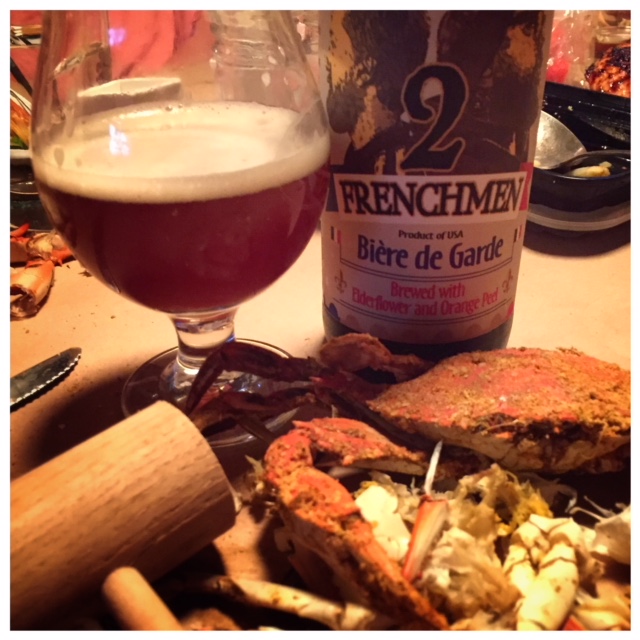“I remember the first time I tasted Saison Dupont. My beer life had changed in an instant and forever.”
THE SESSIONS #136 BEER BLOGGING FRIDAY The Session, a.k.a. Beer Blogging Friday, is an opportunity once a month for beer bloggers from around the world to get together and write from their own unique perspective on a single topic. Each month, a different beer blogger hosts the Session, chooses a topic and creates a round-up listing all of the participants, along with a short pithy critique of each entry.
David at Brewing In A Bedsitter hosted The Session #136 - Beer Blogging Friday — for June 2018. His theme for this month was Farmhouse Beers.
David's intro to the theme... Whether it's about the success of modern craft breweries like Jester King and Burning Sky, the worldwide spread of saison or the revival of international interest in Northern European traditions, farmhouse brewing is an recurring theme in the beer world. It's a very resonant idea but also one that invites many perspectives, so it seems like an ideal topic for the collective conversation that is The Session.
Farmhouse Beer
I didn't know what a farmhouse beer was. I guess for most modern beer enthusiasts that was true at one point. Then as your palate and curiosity grews, it has to happen. What is a saison? I guess I'll try it!
Craft Beer Radio — Savor 2014
Well, it use to be true that the SAVOR event hosted by the Brewers Association would hold a series of salons (learning sessions). Registrants could choose one salon to attend from a variety of topics. While that was a highlight of the evening for me, almost as good was that Craft Beer Radio would record these salons and post them for later listening. One evening at the SAVOR 2014 event the topic was Saisons. The link below will allow you to listen in these years later.
- Saisons: Running the Gamut
Saisons are a style of farmhouse ale with historical roots in Belgium that was once on the verge of extinction. Their popularity in the U.S. has recently skyrocketed due to craft brewers embracing the style and putting their own twist on it. Join in a tasting of four distinctive saisons brewed by four different breweries who have brought their own artistry to the classic style.
Farmhouse According to BJCP
Of course it is difficult to discuss a beer style that many may not know or understand without referencing the authorities of style.
The Beer Judge Certification Program (BJCP) is one of two definitive beer style programs. The other being the Brewers Association. If you review the 2015 guidelines and search for "farmhouse" many beers carry that note. However, according to the style guide only three are classified as farmhouse beers. And for many beer aficionados, their is a single style that is most commonly carries the name and is synonymous with farmhouse — saison.
The 2015 BJCP Style Guidelines does an interesting twist on beer styles — it offers a variety of views in which to group styles. One sorting is based on a beers history.
Styles Sorted Using History
This system attempts to break the styles into groups based on historical development and derived styles in a more granular approach than the style family sorting.
European Farmhouse Beer
The BJCP lists three distinct beer styles under the historic farmhouse banner.
- Bière de Garde
- Saison
- Historical Beer (Sahti)
Saison
“The Saison yeast character is a must, although maltier and richer versions will tend to mask this character more. Often called Farmhouse ales in the US, but this term is not common in Europe where they are simply part of a larger grouping of artisanal ales.”
History: A provision ale originally brewed in Wallonia, the French-speaking part of Belgium, for consumption during the active farming season. Originally a lower-alcohol product so as to not debilitate field workers, but tavern-strength products also existed. Higher-strength and different-colored products appeared after WWII. The best known modern saison, Saison Dupont, was first produced in the 1920s. Originally a rustic, artisanal ale made with local farm-produced ingredients, it is now brewed mostly in larger breweries yet retains the image of its humble origins.
Simple and True — The Story of Saison Dupont
If you don't know about Good Beer Hunting with Michael Kiser, he heads up a collective of beer centric articles and podcasts. GBH is definitely worth following for learning the inside-beer commentaries and exposures. Kiser, makes no bones about it, he loves Saison Dupont. He declares this is the beer that turned his head as to what beer could be and was the inspiration for GBH. He traveled to the Belgian brewery and wrote about the experience in the expose Simple and True: The Story of Saison Dupont.
Bière de Garde
History: Name literally means “beer which has been kept or lagered.” A traditional artisanal ale from northern France brewed in early spring and kept in cold cellars for consumption in warmer weather. It is now brewed year-round.
Characteristic Ingredients: The “cellar” character commonly described in literature is more of a feature of mishandled commercial exports than fresh, authentic products.
The somewhat moldy character comes from the corks and/or oxidation in commercial versions, and is incorrectly identified as “musty” or “cellar-like.” Base malts vary by beer color, but usually include pale, Vienna and Munich types. Darker versions will have richer malt complexity and sweetness from crystal-type malts. Sugar may be used to add flavor and aid in the dry finish. Lager or ale yeast fermented at cool ale temperatures, followed by long cold conditioning. Floral, herbal or spicy continental hops.
Style Comparison: Related to the Belgian Saison style, the main difference is that the Bière de Garde is rounder, richer, malt-focused, and lacks the spicy, bitter character of a Saison.
Sahti
History: An indigenous traditional style from Finland; a farmhouse tradition for at least 500 years, often brewed for festive occasions like summer weddings, and consumed within a week or two of brewing. A similar tradition exists in Estonia, where the beer is known as koduolu.
Characteristic Ingredients: Malted barley along with malted and unmalted grains, often rye. Low hops. Juniper boughs used for lautering (traditionally in a hollowed-out log), but often producing a juniper/berry character. Often uses top-fermenting baker’s yeast in a fast, warm fermentation (German Weizen yeast is a good substitute). Not boiled; a long mash steep is used, with a separately added hop tea.
The best example I am aware of is the Dogfish Head Sah'tea. While Dogfish is a favorite brewery of mine, I'm not sure I've tasted this beer. One thing is certain, next time I see it on the beer shelf I will be bringing it home.
“This Ancient Ale is a modern take on a 9th-century Finnish beer. The wort for Sah’tea is caramelized over white-hot river rocks, and the beer is fermented with a German weizen yeast. In addition to juniper berries foraged from the Finnish countryside, Sah’tea is flavored with black tea.”
Favorites
Since discovering and learning to love the beer style or group of styles, some favorites have emerged. The Boulevard Tank 7, Ommegang Hennepin, Brooklyn Sorachi Ace, Stillwater's Stateside Saison, and of course Saison Dupont. There certainly are many more and brewers are always adding to the list.
Farmhouse Now
Farmhouse beers are now a sought-after beer style for me, whether the famous Saison Dupont or another take on the style. Living on the Eastern Shore of Maryland USA means steamed crabs in the summer, oysters and clams in the winter and fresh fish all the time. And no other beer quite matches the delicate flavors of fresh seafood as a saison or Bière de Garde. So, make mine a saison please and be sure to throw in a dozen crabs. Cheers!
The Session Round-up
If you would like to read what other writers shared their thoughts on Farmhouse Beer, they can be discovered in the Round-up.





